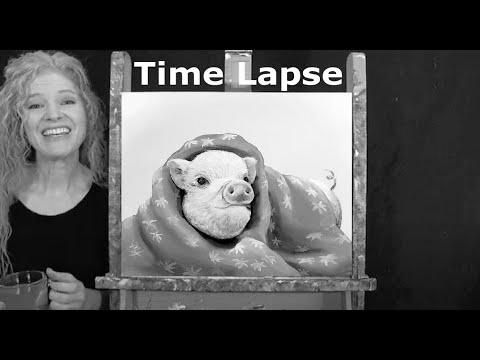TIME LAPSE – Be taught How to Paint "PIG IN A BLANKET" with Acrylic Paint- Step by Step Video Tutorial
Warning: Undefined variable $post_id in /home/webpages/lima-city/booktips/wordpress_de-2022-03-17-33f52d/wp-content/themes/fast-press/single.php on line 26

Learn , TIME LAPSE - Be taught Learn how to Paint "PIG IN A BLANKET" with Acrylic Paint- Step by Step Video Tutorial , , aBmAJDoY1Dk , https://www.youtube.com/watch?v=aBmAJDoY1Dk , https://i.ytimg.com/vi/aBmAJDoY1Dk/hqdefault.jpg , 4842 , 5.00 , PAINTING VIDEO DESCRIPTION – This is a time lapsed model on how one can paint this cute animal portrait picture of "PIG IN A ... , 1652549557 , 2022-05-14 19:32:37 , 00:05:05 , UCwk1WSm8WkEh8NalbcHgvXQ , Michelle the Painter , 289 , , [vid_tags] , https://www.youtubepp.com/watch?v=aBmAJDoY1Dk , [ad_2] , [ad_1] , https://www.youtube.com/watch?v=aBmAJDoY1Dk, #TIME #LAPSE #Study #Paint #quotPIG #BLANKETquot #Acrylic #Paint #Step #Step #Video #Tutorial [publish_date]
#TIME #LAPSE #Learn #Paint #quotPIG #BLANKETquot #Acrylic #Paint #Step #Step #Video #Tutorial
PAINTING VIDEO DESCRIPTION – It is a time lapsed version on methods to paint this cute animal portrait picture of "PIG IN A ...
Quelle: [source_domain]
- Mehr zu learn Learning is the physical entity of acquiring new reason, knowledge, behaviors, skills, values, attitudes, and preferences.[1] The ability to learn is berserk by mankind, animals, and some equipment; there is also inform for some kind of encyclopedism in convinced plants.[2] Some eruditeness is present, iatrogenic by a undivided event (e.g. being unburned by a hot stove), but much skill and cognition amass from continual experiences.[3] The changes induced by education often last a period of time, and it is hard to qualify conditioned substantial that seems to be "lost" from that which cannot be retrieved.[4] Human learning starts at birth (it might even start before[5] in terms of an embryo's need for both action with, and freedom inside its state of affairs within the womb.[6]) and continues until death as a result of on-going interactions between folk and their surroundings. The trait and processes caught up in eruditeness are designed in many established w. C. Fields (including instructive psychological science, psychological science, experimental psychology, psychological feature sciences, and pedagogy), besides as nascent fields of knowledge (e.g. with a distributed interest in the topic of encyclopedism from safety events such as incidents/accidents,[7] or in collaborative education condition systems[8]). Research in such fields has led to the designation of different sorts of eruditeness. For illustration, encyclopedism may occur as a consequence of habituation, or classical conditioning, conditioning or as a result of more complex activities such as play, seen only in comparatively born animals.[9][10] Encyclopedism may occur consciously or without conscious knowingness. Eruditeness that an dislike event can't be avoided or on the loose may effect in a shape titled well-educated helplessness.[11] There is show for human behavioral learning prenatally, in which dependence has been observed as early as 32 weeks into biological time, indicating that the cardinal nervous organization is insufficiently matured and primed for learning and memory to occur very early in development.[12] Play has been approached by single theorists as a form of learning. Children experiment with the world, learn the rules, and learn to interact through play. Lev Vygotsky agrees that play is crucial for children's growth, since they make substance of their state of affairs through and through musical performance acquisition games. For Vygotsky, however, play is the first form of encyclopaedism language and human action, and the stage where a child begins to see rules and symbols.[13] This has led to a view that encyclopaedism in organisms is forever related to semiosis,[14] and often related with nonrepresentational systems/activity.
Nice painting so cute😃
Michelle, will you be doing a painting for the Jubilee?
Can u paint a snow landscape with a detailed snowflake 😅
So cute!❣️🐷
Oh!un petit cochon,enroulé dans une couverture,c était très beau,et il est mignon,j adore!😀
It's wonderful your painting
✅♥
Espectacular trabajo!!!
Fascinante!!!
Gorgeous …❤❤❤ gooooood job!! Hope one day we paint together.
Adorable! Put an INSTANT smile on my face.
So very cute, as well as everything you do. So gifted, I watch every one I can.
You are quite versatile ! Love it… !
How would I do this if I wanted the pig to be black?
Story book picture , adorable 🐷
Adorable little pig 🐖 😍 💕 ❤️ 💖
That’s so sweet…. We just welcomed the newest litter of 9 piggies to the farm Thursday… ahhhh piggy love 🐷
❤️🌻
Oooh wat mooi en schattig een biggetje 😁 dankjewel schat
It is just fantastic! Great use of color.
This is really ingenious Michelle. A sure thing to bring a smile to the face 😍
ΥΟU ARE GREAT..
🥰🥰🥰💕💕💕❣️❣️
Oh too cute 😊👏👏👏
Adorei!!!👏🏻👏🏻
Very cute